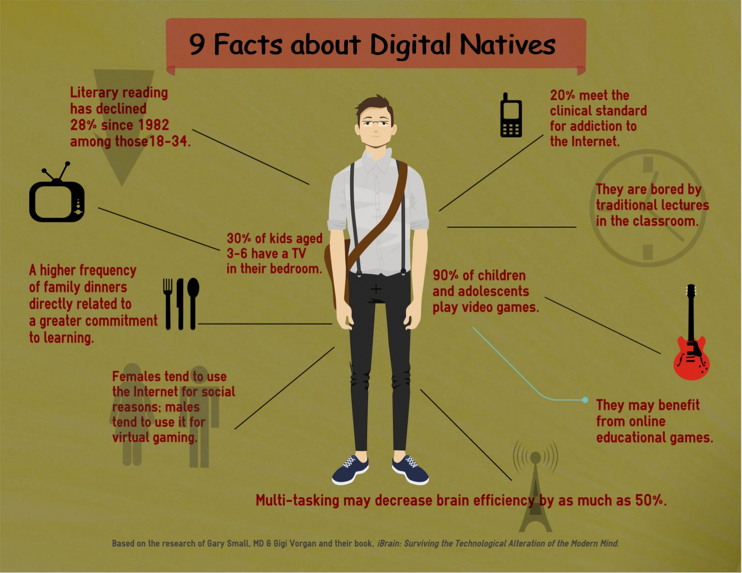
Structuring lesson plans to appeal to Digital Natives
Understanding learner styles
The infographic above is very revealing. It seems to support the main idea Prensky put forward in his work Digital Natives, Digital Immigrants, “Digital Immigrant teachers assume that learners are the same as they have always been and that the same methods that worked for the teachers when they were students will work for their students now” (Prensky, 2001: 1). That is to say, that whilst a popular, and cost-effective method for teaching the masses, traditional, teacher-centred, lectures are losing their appeal for digital natives. But why? Well, lectures are often characterised by a sole teacher delivering a protracted monologue to a large group of students. The idea is that students sit back, relax, and magically absorb the information coming forth from the teacher’s mouth. Is that how all students learn? Well, for those with an aural learning style, who are good at remembering what they are told, yes. Perfect. But what about those visual, reading/writing and kinaesthetic learners as identified in Fleming’s VARK model? It seems that these groups are largely uncatered for. Following Fleming’s inventory, then, something more active to stimulate physical movement and/or providing grapic displays, images and videos, would make any lesson plan more appealing to Digital Natives.
Understanding learner digital habits
There is also strong evidence here that the young people interact with technology, not only in the classroom, but at home, and during their free time. This is supported by Prensky’s insight, “”It is now clear that as a result of this ubiquitous environment and the sheer colume of their interaction with it, today’s students think and process information fundamentally differently from their predecessors” (Prensky, 2001: 1). The fact that most youngsters enjoy playing video games means that an engaging lesson plan may include either, an explicit online game, or, a game that implicitly includes key elements of a video game that make it so popular (graphic images, risk/reward, time limit, multi-player). Following on, then, we need to be aware that there is a gender divergence in how the sexes interact with technology. However, rather than splitting the class along gender-specific lines in order to carry out an activity, I would suggest a range of activities that appeal to both groups, would be more effective.
Understanding the power of reading
Finally, this graphic highlights the sad but true situation of a general decline in literacy skills in young adults. This is sad because there is a statistical link between literacy and people’s life chances. That is to say, someone with poor literacy is likely to have a disadvantaged life experience, characterised with. By contrast, those who read for pleasure when they are young, are likely to better at school, at university, and may equate to getting a good job after graduation. If there is an issue with getting young people to read, and we know that they have a strong interest in digital technology, then we should look at ways that integrate those fundamental components. Indeed, Prensky claims that the biggest issue for teacher’s today not being technically-savvy which is a gross mis-service to students: “…the single biggest problem facing education today is that our Digital Immigrant instructors, who speak an outdated language (that of the pre-digital age), are struggling to teach a population that speaks an entirely new language” (Prensky, 2001: 1). Audiobooks, electronic ‘talking’ books and ebooks come to mind. For more ideas check out Doug Johnson’s wiki page, Using Technology to Encourage Free Voluntary Reading and The Digital Media diet’s Tips on Encouraging Kids to Read in the Digital Age.
The Vark Categories. (n.d.) Retrieved from http://www.vark-learn.com/english/page.asp?p=categories
Digital Natives, Digital Immigrants, Prensky, 2001
National Literacy Trust, Literacy Changes Lives: advocacy resource, 2008, Retrieved from http://www.readforgood.org/docs/literacychangeslives.pdf

